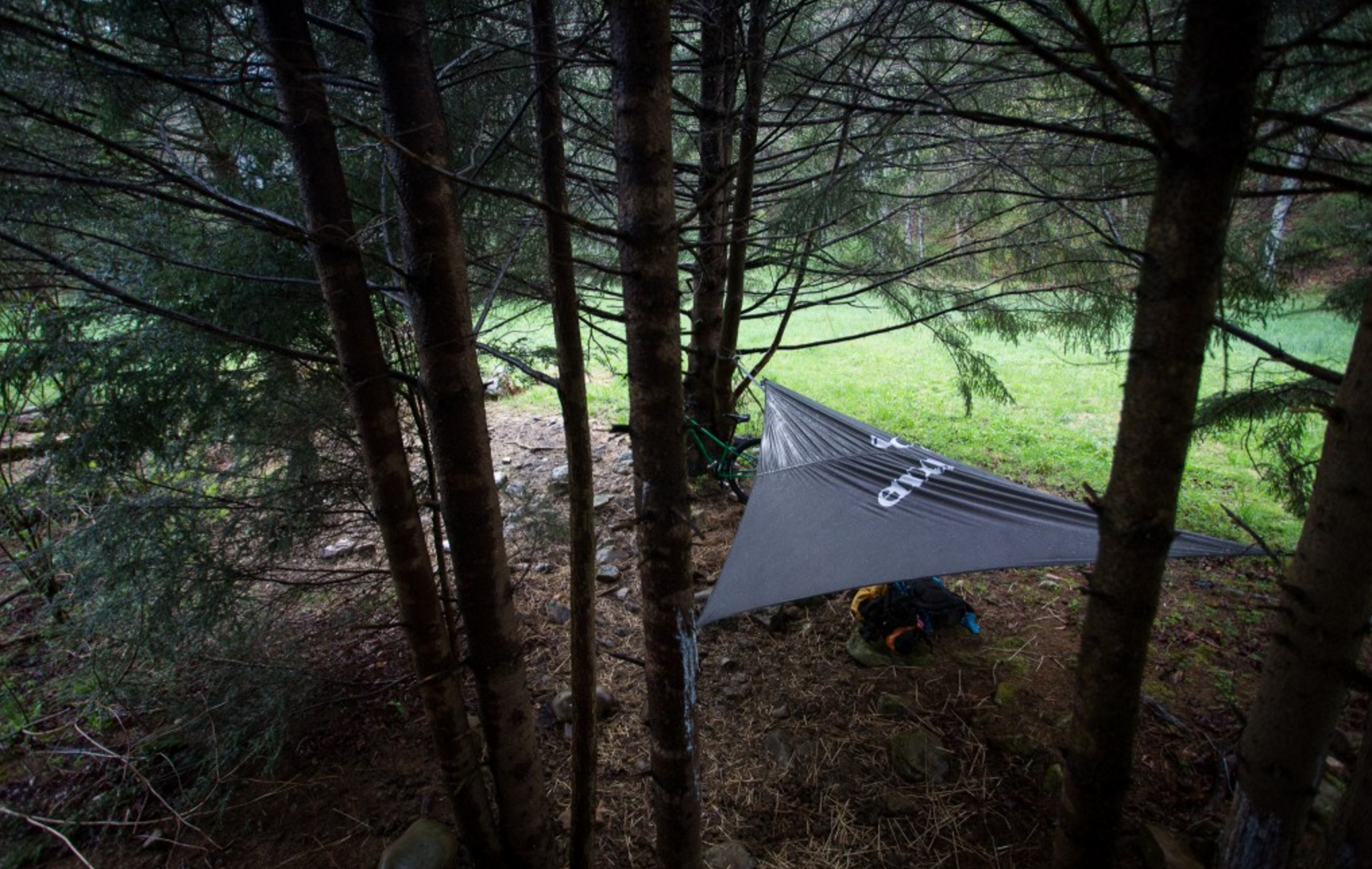The cool breeze gently swayed my hammock, rustling the boughs of the pine trees above me. A faint sliver of sunlight peaked through my tarp. I could hear Adam’s gentle breathing in the hammock next to me. He shifted positions, still deep in sleep, the fabric groaning under his weight.
The hour digit pinged 7 a.m. on my watch. I turned off the beeping alarm before it could disturb him. Sliding out of my sleeping bag, I quietly inched away to the lake we were camped beside. Its placid waters hardly stirred in the early morning dawn, the stillness mirroring my own inner stillness. I stretched, feeling suddenly very awake. I had slept through the night without waking once, an accomplishment in and of itself for any overnighter in the woods, let alone one spent in a hammock.
Adam and I have spent a fair amount of time swingin’ from the trees. In 2014, during his thru-hike of the Appalachian Trail, Adam camped every night in the ENO hammock he bought when he was 16. During my 2011 NOLS semester in the Amazon, I slept in a hammock for nearly two months, after which I immediately bought my own hammock setup. Clearly, something about sleeping between two trunks spoke to us.
We’ve had our bouts of failure, for sure: misjudged tree distances, unexpected storms, insufficient rigging, relentless bugs (there’s also that one time I fell out of my hammock that I don’t like to talk about…I may or may not still have some residual bruising). It’s not unlike a work of art, setting up the perfect hammock camp. There’s a finesse to it, a proficiency that comes only with time.
So if you’ve just recently made the swap from tent to hammock (or are thinking about it), check out our top 10 tips and tricks for getting the perfect hammock camp!
Make it work for you.
Adam likes his hammock a little loose, with his head higher than his feet. I like mine a little tighter, a little straighter, so I can spread out diagonally and feel as if I’m laying on a bed. Don’t listen to any one person’s advice on hammock rigging. Experiment, and get it comfortable for your body!
Set up your rain tarp, even if it’s sunny.
Chances are, you’re going to be camping in the mountains, where fickle weather patterns can change without a moment’s notice. Even if you only set up your tarp halfway, at least you’ll know it fits the distance between the trees before the storm lets loose.
Always have a drip line.
There’s nothing worse than waking in the middle of the night to discover that, while your tarp might be holding up just fine, your hammock is still soaking up water from the tree straps. Fashion a little cordelette on either end of your hammock, attaching it to the carabiners, and watch the water trickle down the line and away from your cozy cocoon.
Try rigging a ridgeline.
I always carry enough additional cordelette, longer than the length of my hammock, to fashion a ridgeline. This line runs directly over my hammock, and while some use it to support their tarp (try tying two prusiks to keep it taut), I like to use mine to hang headlamps and wet socks as well. If you want to get real fancy, ENO makes some cool Twilight backcountry Christmas lights which can easily wind around the ridgeline for additional lighting. While a little less fancy, their Moonshine Lantern serves a similar function and comes equipped with a hook for hanging on your ridgeline.
Invest in a non-inflatable sleeping pad.
Adam and I both use Therm-a-Rest Z Lites, which are lightweight and flexible. You might not think you’ll need it, but trust us—that gentle breeze rocking you to sleep will also, eventually, make you numb with cold. You don’t need much, just another layer between you and the fabric, but it’s essential.
Come prepared with stakes.
Not every campsite is going to have perfectly placed roots, rocks, or other natural elements to secure your tarp to. Stakes take the guessing out of rigging, though if you do happen to forget (or worse, lose) your stakes, try burying a solid stick horizontally under six inches of soil. Place a hefty rock or other weighty object on top, just for some extra security.
Higher is not better.
So, though it feels really cool to be swinging up high in the trees with your feet dangling below you, it’s not a very practical place to be hanging out all night. For starters, getting in a hammock is hard enough close to the ground, let alone when you have to jump up into it. Secondly, if and when a storm hits, you want to be as low to the ground as possible (try for two to three feet) so the wind isn’t gusting rain up underneath the tarp.
Secure everything.
Curious critters, wind, rain, you name it, if it’s not put away before you hit the hay, it could very well be gone or damaged tomorrow. Hang your pack from the hammock’s carabiner. Tie your shoelaces together and slap ’em over your ridgeline. Make everything neat and stormproof, so that even if it’s your first time in the backcountry, at least you look like you know what you’re doing.
Consider a groundsheet.
When you opt for a hammock instead of a tent, all of a sudden, simple things like changing clothes and putting on shoes can become chores. Make it easy with a groundsheet. Adam carried a piece of Tyvek with him on the trail (which he also staked out) so he could have a nice clean, dry surface to stand on before getting in his hammock. This also helps reduce the amount of gravel and dirt that inevitably winds up in your hammock, too.
Be conscientious about your hammock’s position.
If it’s windy, don’t set your hammock up so that it acts like a sail and less like a bed. If you have even the faintest hint of breeze in the air, notice it, and try to avoid hanging your hammock so that it’s broadside to the draft. There’s truly nothing more annoying than hearing your tarp flap against your hammock all night long.











